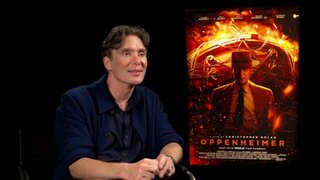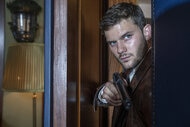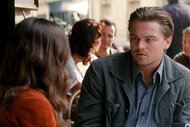Create a free profile to get unlimited access to exclusive videos, sweepstakes, and more!
How They Created Those Amazing Inception Special Effects, Which Still Hold Up More Than a Decade Later
We'd expect nothing less from a guy who refused to use CGI for the atomic detonation scene in Oppenheimer.
Writer/director/producer Christopher Nolan raised many eyebrows in 2022 when he teased a cinematic recreation of the Manhattan Project's Trinity detonation without a single frame of CG-generated imagery in Oppenheimer, his then-upcoming biopic of theoretical physicist J. Robert Oppenheimer.
And before you ask, the answer is a big fat NO: the production did not set off an actual atomic device somewhere. That would have been insane, not to mention a direct breach of 1963's Limited Nuclear Test Ban Treaty. Instead of spreading radiation into the atmosphere and groundwater, the filmmaker challenged Special Effects Supervisor Scott R. Fisher to experiment with old school methods involving forced perspective and safer explosive materials like gasoline, propane, aluminum powder, and magnesium.
Nolan's preference for employing practical effects wherever possible is nothing new. Like the feuding magicians in The Prestige, he is always looking for the most effective way to pull off a grand illusion and trick the audience into believing what they are seeing is the genuine article. Cinema, after all, is a medium of artifice, and while digital tools are constantly evolving, they become obsolete just as fast. What passed as groundbreaking CGI 20 years ago is laughable by today's standards. On the other hand, "older" movies like Star Wars, The Thing, Gremlins, and The Fly remain timeless because of their tangible, hand-crafted set pieces. Not only do they feel more authentic, but a director will generally get a better performance out of the film's cast if they're given something they can react to in real time.
Why Inception's special effects still hold up over a decade later
Nowhere is Nolan's commitment to practical artistry more apparent than in 2010's Inception (now streaming on Peacock), a film all about realizing the limitless potential of the human imagination and, as many have pointed out over the years, an allegory for the filmmaking process itself. Of course, some digital fakery would be required to make the ambitious project a reality, but that always came second, as a way to enhance what had already been achieved in-camera.
Take, for instance, the memorable sequence in which a Parisian street begins to explode all around Cobb (Leonardo DiCaprio) and Ariadne (Elliott Page). The destruction was not a post-production afterthought. Both DiCaprio and Page were present at the cafe while Special Effects Supervisor Chris Corbould rigged air cannons to shoot real, albeit harmless, debris around them. “[They were in] their own little safety area, where even the paper cup on the table didn’t move," Corbould explains in the featurette embedded above.
“I always knew there’d be a massive computer graphics component and visual effects component to this sequence. But it was very important to me that we shot as much of it as possible in-camera to really give the visual effects guys the chance to do what they do best, which is to build on or enhance things that have existed in the real world, things that have been photographed," Nolan adds. "They have that for reference."
Another great example of the lengths Nolan went to realize an almost intangible concept in a three-dimensional space arrives around the 40-minute mark when Cobb's right-hand man, Arthur (Joseph Gordon-Levitt), demonstrates how the paradoxical nature of the Penrose steps can be turned to one's advantage inside a dream. The "infinite staircase" was done practically through the cooperation of production designer Guy Hendrix Dyas, cinematographer Wally Pfister, and VFX Supervisor Paul Franklin.
"[Nolan's] first question to me was, ‘Can you build a Penrose Step that actually works?’ And I said, ‘Well, of course you can!’ But actually, it’s almost impossible," Dyas explains in Visual Impact Systems' making-of featurette. "We’d fitted the set into a location, which was sort of a disused games facility that was constructed of steel and glass. It was one of those typical modern, beautiful buildings. We’d designed this staircase in the same wood as the stairs that they had at this facility. So it almost looked like it was part of the environment."
Despite the fact that the illusion was accomplished via optical trickery rather than with CG fabrication, Franklin and Pfister relied on contemporary VFX pre-visualization as a way to calculate where the camera needed to be placed and how it would move. "We were able to make computer models of all of this and work out exactly the dimensions of the steps that have to be built and where the camera has to be in three-dimensional space to be able to film it," Franklin says.
“It had to be done mathematically perfect," echoes Pfister. "And [when filming the scene] it had to be a particular lens at a particular height and distance and the camera had to drop in a particular way to hide the trickery."
When all was said and done, Nolan and his talented crew had pretty much relied on every trick in the visual storytelling book to pull the wool over the viewer's eyes. For the zero gravity hallway fight with Robert Fischer's body guard projections, two identical rigs, one horizontal and one vertical, were built for shooting purposes. The horizontal set was capable of rotating 360 degrees, while the vertical iteration allowed for actors and stunt people to be lowered down on wires toward the camera at the bottom.
"In the final edit, what you see is shot to shot to shot. It tends to be a different orientation, a completely different rig in each shot," Nolan says in the video just above. "And I think that, more than anything else, really stops the audience seeing the trick of how these things are done."
Inception is now streaming on Peacock.
Originally published Feb 23, 2024.






























